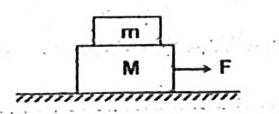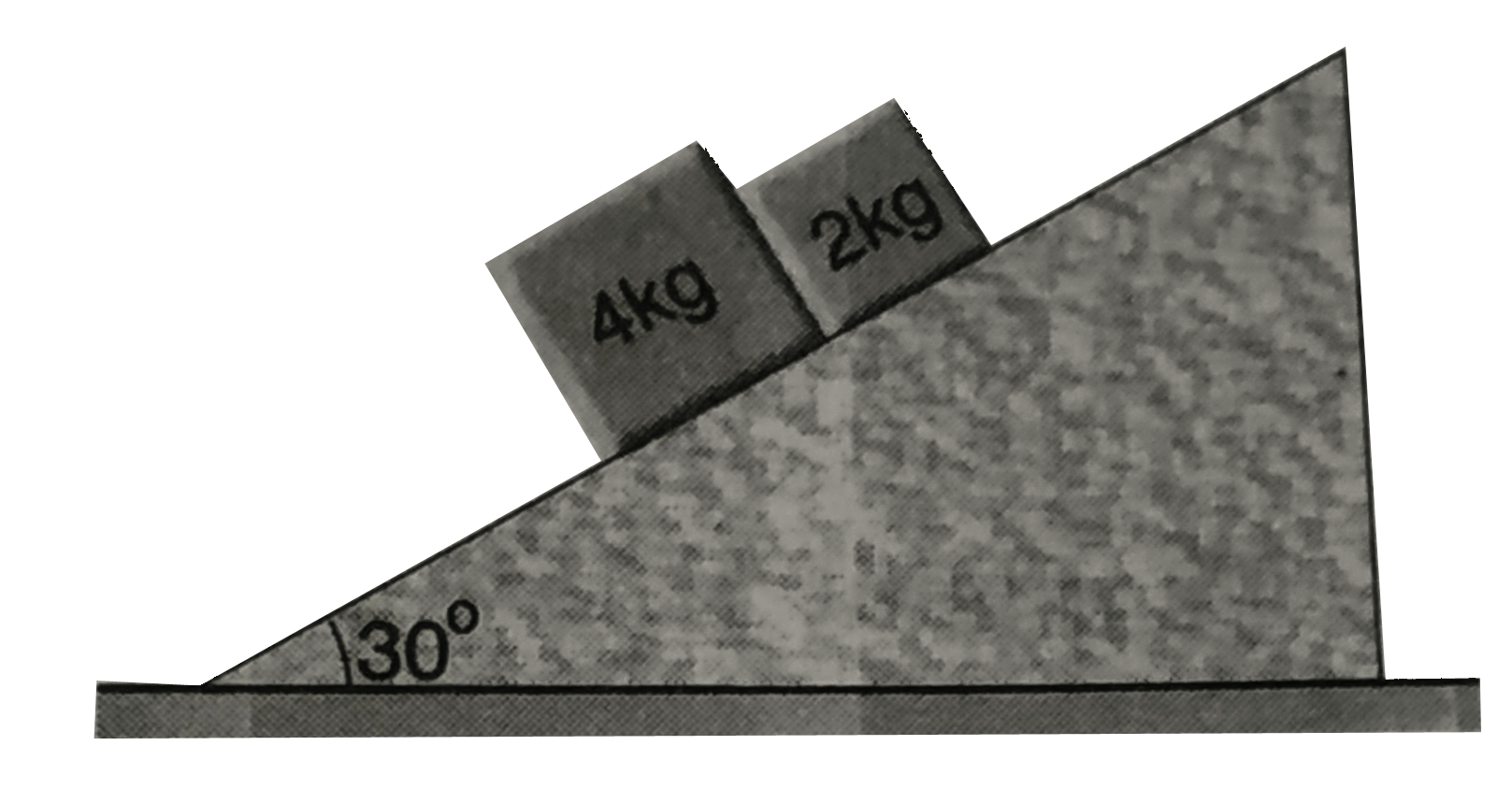Friction coefficients at all surfaces in the given setup is μs=0.5 μk=0.20 .Find the minimum acceleration of the block of mass 2kg so that smaller block of mass 0.5kg remains at rest wrt 2kg (g=10m/s^(2))
Step by step video & image solution for Friction coefficients at all surfaces in the given setup is mu_(s)=0.5 mu_(k)=0.20 .Find the minimum acceleration of the block of mass 2kg so that smaller block of mass 0.5kg remains at rest wrt 2kg (g=10m/s^(2)) by Physics experts to help you in doubts & scoring excellent marks in Class 12 exams.
Similar Questions
A block of mass m is placed on another block of mass M lying on a smooth horizontal surface as shown in the figure. The co-efficient of friction between the blocks is μ. Find the maximum horizontal force F (in Newton) that can be applied to the block M so that the blocks together with same acceleration? (M=3kg,m=2kg,μ=0.1,g=10m/s2)
 View Solution
View SolutionIf coeffiecient of friction between the block of mass 2kg and table is 0.4 then out acceleration of the system and tension in the string. (g=10m/s2)
 View Solution
View Solution
Knowledge Check
- Question 1 - Select One
A disc of radius R=2m starts rotating wth constant angular acceleration α=(2rad)/s2. A block of mass m=2kg is kept at a distance R2 from the centre of disc. The coeffiecient of friction between disc and block is μs=0.4,μk=0.3. Acceleration of block when it just slips w.r.t. ground and w.r.t. disc are respectively−(g=10ms−2)
A3ms−2,1ms−2B1ms−2,3ms−2C4ms−2,1ms−2D4ms−2,3ms−2 - Question 2 - Select One
A system of two blocks is shown in figure. Friction coefficient between 5 kg and 10 kg block is μ=0.6 and between 10 kg and ground is μ=0.4 What will be the maximum value of force F applied at the lower block so that 5 kg block does not slip w.r.t. 10 kg . (g=10m/sec2). The force applied at the upper block is having fixed magnitude of 80 N (both forces start to act simultaneously)
 A160 NB250 NC210 ND310 N
A160 NB250 NC210 ND310 N
A block of mass 8 kg is sliding on a surface inclined at an angle of 45∘ with the horizontal. Calculate the acceleration of the block. The coefficient of friction between the block and surface is 0.6. (Take g=10m/s2)
View SolutionA block of mass 8 kg is sliding on a surface inclined at an angle of 45∘ with the horizontal . Calculate the acceleration of the block . The coefficient of friction between the block and surface is 0⋅6 ( Take g = 10m/s2)
View SolutionBlock A has a mass of 30kg and block B a mass of 15kg . The coefficient of friction between all surface of contact are μs=0.15 and μs=0.10 Knowing that θ=30∘ and that the magnitude of the force F applied to block A is 250N Determine (a) acceleration of block A and (b) the tension in the rope
 View Solution
View SolutionFigure shown two blocks in contact sliding down an inclined surfase of inclination 30∘. The friction coefficient between the block of mass 4.0kg and the incline is μ2=0.30. Find the acceleration of 2.0kg block. (g=10m/s2)
 View Solution
View SolutionCoefficient of kinetic friction between 3 kg and 2 kg block is 0.25. The horizontal table surface is smooth. Find the acceleration (in S.I. unit) of the block of mass 10 kg.
 View Solution
View SolutionA block of mass 0.5 kg rests on a wedge of mass 2 kg as in Fig. 7.87 . The wedge is acted on by a horizontal force F and slides on a frictionless surface . If the coefficient of static friction between the wedge and the block is μs=0.8 , and the angle of inclination is 30∘ , find the maximum and minimum values of F for which the block does not slip . Take (g = 10m/s2)
 View Solution
View Solution
